ARTICLES
 |  | 39 / 43 |  |  |
![]()
![]() Joysticks Cheetah Marketing
Joysticks Cheetah Marketing
Articles associés:
Les principaux joysticks de l'époque

Cheetah Marketing was a United Kingdom-based company that produced electronic music-related hardware products and software for home computer systems during the 1980s. They later changed their name to Cheetah International Ltd.
Based in Cardiff, Cheetah was run by two brothers, Howard and Michael Jacobson, but owned by Cannon Street Investments. The company was closed in 1993 when the UK recession badly hit the share price of its owners. After this Chris Wright and Nick Owen bought the music products division and formed Soundscape Digital Technology Ltd. The joysticks and other computer peripheral products division went to another company in the Cannon Street group.
The company originally produced joysticks for the Commodore 64 and Sinclair ZX Spectrum computers and later branched out into music peripherals and stand-alone musical equipment for price conscious home users.
Among their offerings were the SpecDrum (a sample-based drum machine), a sound sampler, a MIDI interface and a range of music keyboards.
Joysticks and peripherals included the Cheetah 125, Cheetah 125 Plus, Mach 1, and an infrared joypad.
Cheetah's range of music products expanded quickly during the 1980s when they began to work with external designers. Among these were Chris Wright, who later founded Soundscape Digital Technology, Ian Jannaway, who later founded Novation Digital Music Systems and Mike Lynch, who later founded Autonomy Corporation.
Cheetah also distributed the Gamate handheld console in the UK.
Wikipedia
Publicités
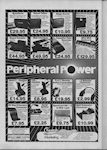 |
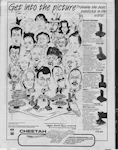 |
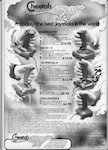 |
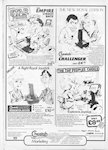 |
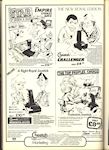 |
125 et 125+
125+ Cheetah
The cheetah 125+ joystick is a pistol-grip type of device with a thumb button on the top of the stick and a trigger for your fore-finger. There is also the addition of two buttons on the ample, rounded, base. The moulding of the stick is very curvacious and fits the hand nicely, the base has four suction cups on it to secure the stick firmly to a smooth surface.
The cable is about a yard long with two plugs on the end. This split adaptor also features on the Mach 1+ and is of special interest to Sinclair owners, especially prospective purchasers of the ZX Spectrum 128+2. One of the plugs is a normal Atari-type D9 suitable for the majority of home computers, and the other one as a grey connector for the side of the new Sinclair machine. This second connector is re-wired in the manner that the new machine needs to get its signals, so you don't have to buy those awful SJSI things. My only worry is that, whilst this is a good idea, the way that the first connector has two wires coming out of it may weaken the link at the plug attachment point. As this is an area where a lot of joysticks break, and short of cutting the cable and replacing the plug, it is irreparable.
Also on the stick is the now almost abligatory, auto-fire switch. This is a switch to make the joystick function like a machine-gun, and to save wear and tear on the fire buttons (an area where a joystick is likely to fail first). A lot of modern games have auto-fire detectors that will cut out this facility or make it function to the detrement of the player, but a lot of games will be made more playable - In fact, some games are almost impossible to contend with without an auto-fire feature.
My main gripe with this stick is that it is not very responsive, the internal construction is that of collapsible domes, which usually give the best feedback, however in this case the stick is almost dead in my hand and games can be tricky to play.
However, I would definitely recommend the 125+ for owners of the Spectrum 128+. It has all the features you would expect from an up to date joystick and although a bit lacking in the response department it's an efficient multi-purpose stick and at £8.95 it'a a bargain.
ZX Computing Monthly, November 1986
125+
Cheetah 125+ is one of the first joystick to be compatible with the Spectrum +2's fiendish SJS1 joystick port and the standard Kempston. It sports two plugs on the end of the lead, a black one for standard Kempston purposes and a flashy new grey one, that'll subtly blend with the casing of your Spectrum +2. The 125+ comes with a pistol-grip stick, trigger, top and base buttons and an auto-fire option switch.
Your Sinclair Number 14, February 1987
Cheetah 125+
Contructeur: Cheetah
Distributeur: Micro programmes 5
Note pour Barbarian: 12/20
Note pour Trailblazer: 14/20
Prix: 90 francs
Rapport Qualité/Prix: 13/20Ce joystick sans micro-switches est précis mais assez mou. Les points cardinaux sont sensibles, par contre les diagonales sont très difficiles à saisir, une fois de plus (ce n'est pas le seul mais c'est très désagréable). Le bouton du dessus ne répond pas vraiment au doigt, et encore moins à l'oeil. Pas mal tout de même.
Amstrad Magazine N°26, Septembre 1987
125+ (£8.99)
A fairly large, black plastic joystick modelled firmly along aircraft lines. It's nicely designed, with a comfortable handgrip, four well-places fire buttons, autofire, twin leads (black for 48/128K with suitable interface, grey for +2 and +3) and even a non-slip effect around the base for extra grip. Unfortunately, this is slightly marred by the overall plasticy feel of the thing. That having been said, it proved to be one of the nicest to use and good value to boot! It comes with a 12 month warranty too so you should be okay. Recommended.
Jackie: Sticks well to the desk, but the shaft is a bit wibbly and loose. I like the grip effect and it's got loads of lovely fire buttons all over the place which means you can swop which ones you use and rest your hand.
David: Very light on the controls and quite responsive. Comes off the desk quite easily though because the base is a bit narrow. I'm slightly scared of the durability - it feels quite fragile.
Matt: I like the light touch - it's lot less tiring if you're having a long session with a game. Very precise for shoot'em ups, but not easy to waggle (none of these aircraft style one are). I found it stuck to the table okay, but it's got a very small base compared to how tall it is, so I could see a problem with leverage (ie it might pull off). I like it a lot, it's excellent value, but I'm concerned about how long it would last.
Your Sinclair Number 46, October 1989
Photos
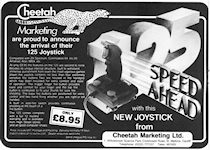 |
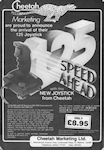 |
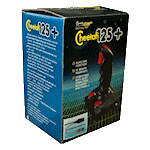 |
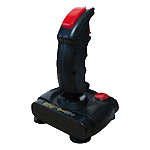 |
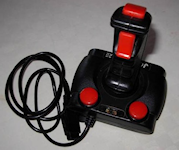 |
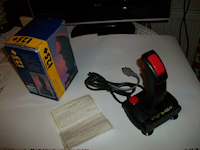 |
Mach 1 et Mach 1+
Mach 1+
The Cheetah Mach 1+ is similar to the 125+ in that it has four fire buttons: two on the base and two on the stick, and in the same positions. However in this case the body of the stick is much bigger and angular and thus more difficult to use and a lot less comfortable than is expected for this kind of money.
Otherwise, the features of the other model are retained - two plugs, auto-fire, suction cups, etc. The internal construction of this stick however, is with micro-switches. These will last virtually forever under normal conditions.
The stick is awkward to hold and so is the base. Micro-switches are not very responsive at the best of times, and that point is proved again with the Mach 1+.
Apart from being very reliable it has little to recommend it over the 125+. If you want a joystick that will never let you down then you've found it with the Mach 1 but for enjoyable play opt for the 125+. The subtantial price differential (£6) may also be a big influence on your choice.
ZX Computing Monthly, November 1986
Mach 1+
Another triffic joystick from Cheetah that's both Kempston and Spectrum+2 compatible. It's got two dinky little plugs on the end of the lead so there'll be no more unsightly wires trailing over your stylish Speccy. Like the Cheetah 125+, it boats a pistol-grip stick, trigger, top and base buttons and auto-fire but it's got a more positive stick action and a sturdier base. What's more it's got suckers on the bottom for extra control. Comfy, controllable and easy to use, this one's well worth the money.
Your Sinclair Number 14, February 1987
Cheetah Mach 1+
Contructeur: Cheetah
Distributeur: Micro programmes 5
Note pour Barbarian: 12/20
Note pour Trailblazer: 14/20
Prix: 170 francs
Rapport Qualité/Prix: 10/20Ce joystick a beau avoir des micro-switches en pagaille, ses boutons de tir sont tout de même détestables. De même que son prix, car nous avons déjà vu des joysticks un tantinets plus performants et moins chers. Les ventouses sont par contre absolument géniales. Elles collent tellement à la table qu'elles se détachent du joystick quand on veut le prendre ! Voilà un joystick qu'il est bon, non ?
Amstrad Magazine N°26, Septembre 1987
Mach 1 (£10.99)
Blimey! Another joystick from Cheetah moulded in black and red with a metal shaft, autofire, four microswitch fire buttons and a one year warranty. Just like the 125+ and the Star Probe in fact! In general, the Cheetahs have very light controls, well placed fire buttons and feel like they might be very strong inside but they're let down by cheap outer casings. And this one's ne exception! Why do they make so many similar sticks?
Jackie: Sits firmly on the desk, but the shaft slopes forward which is a bit disorientating. Pulling back and left and right is fone, but when you push forward it seems to go a long way before you get any effect which is weird. Fire buttons well places for the right hand, but less so for the left.
Matt: Hmm. Sticks down quite well, and the autofire is good, but the placement of the other fire buttons is a bit weird. The normally-quite-useful trigger one is so small as to be almost useless! Good for flight sims though 'cos it's like a real aeroplane stick.
David: A very popular stick - it's not too expensive and there are always loads for sale in Input Output so lots of people have got them. To use the top fire button you have to take your thumb off the stick which loosens your grip, and the trigger one is far too small. A bit wide to hold, but it's light so it doesn't work too badly.
Your Sinclair Number 46, October 1989
Photos
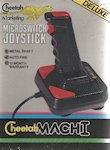 |
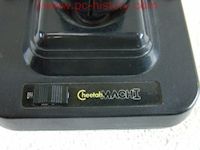 |
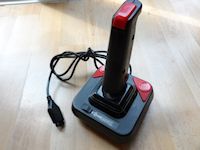 |
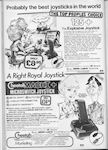 |
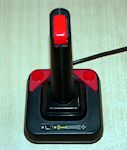 |
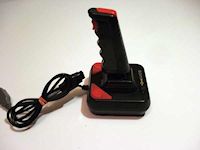 |
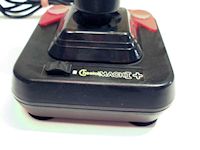 |
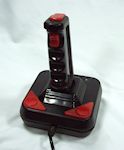 |
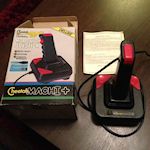 |
Annihilator
Photos
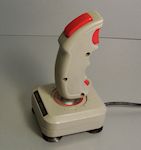 |
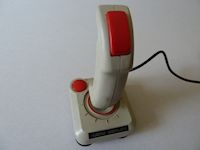 |
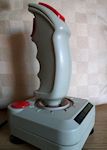 |
Star Probe ou StarFighter
Photos
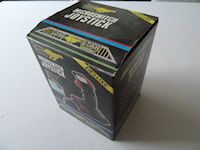 |
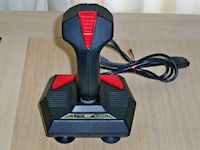 |
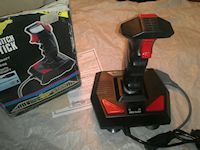 |
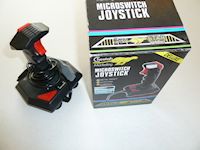 |
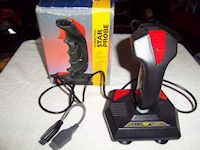 |
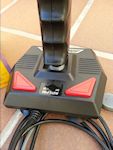 |
Avis de recherche
Si vous possédez des photos ou des articles concernant ces joysticks, n'hésitez pas à nous les faire parvenir.
| Article créé le : | Dimanche 22 Septembre 2013 à 11 h 05 |
| Dernière mise à jour le : | Vendredi 01 Novembre 2013 à 09 h 49 |
Programmation par Kukulcan © 2007-2025 tous droits réservés.
Reproduction sans autorisation interdite. Tous les titres utilisées appartiennent à leurs propriétaires respectifs.
